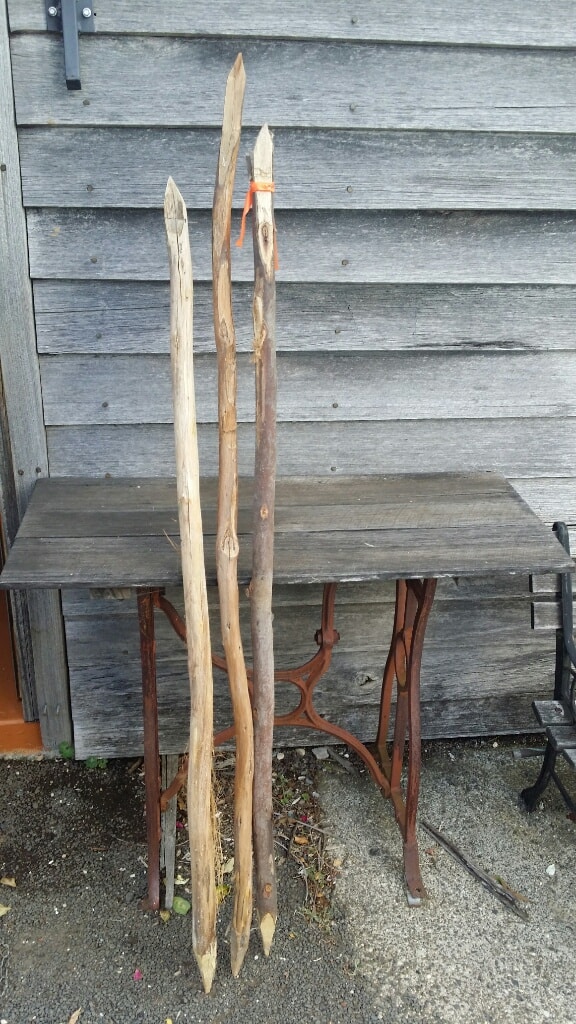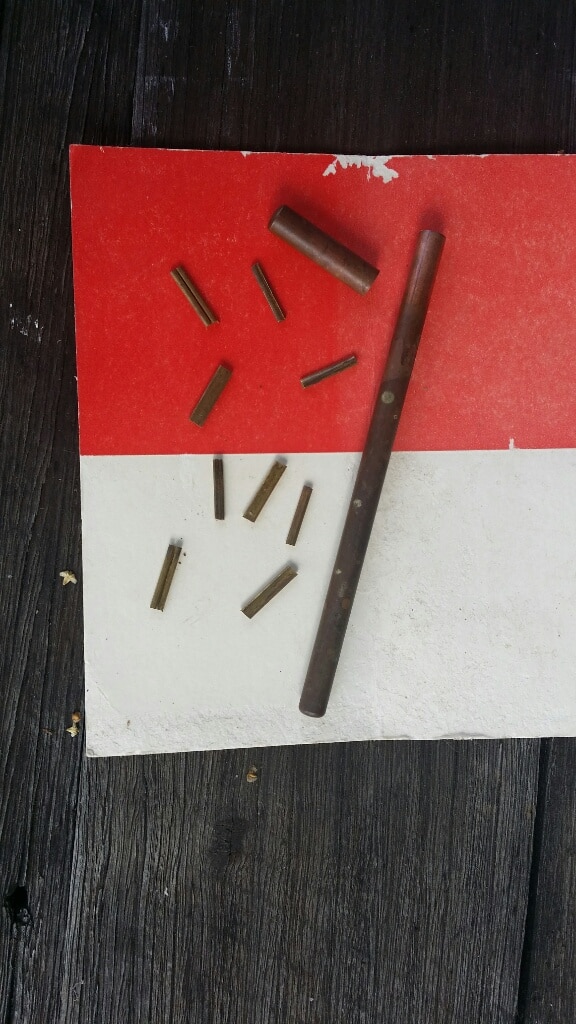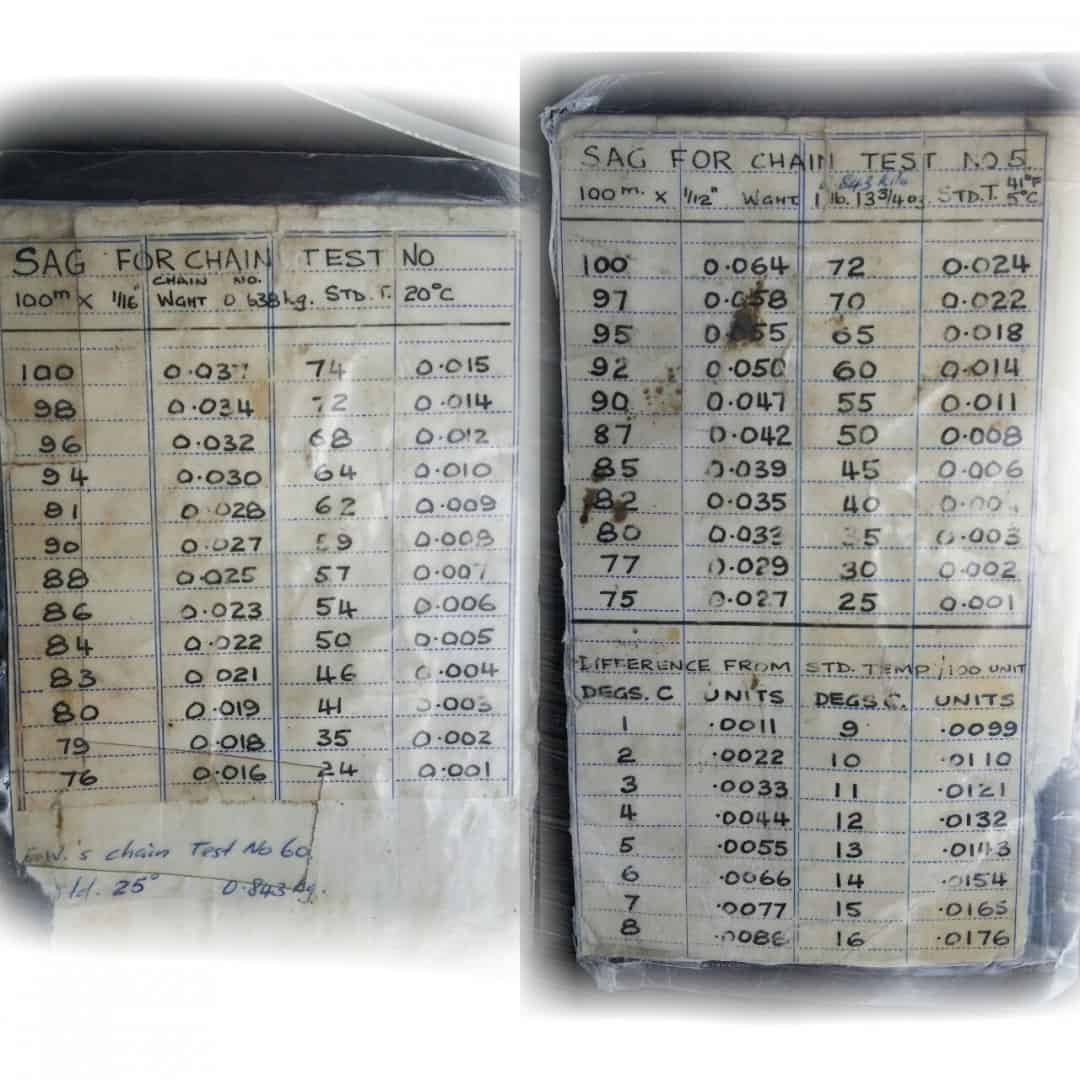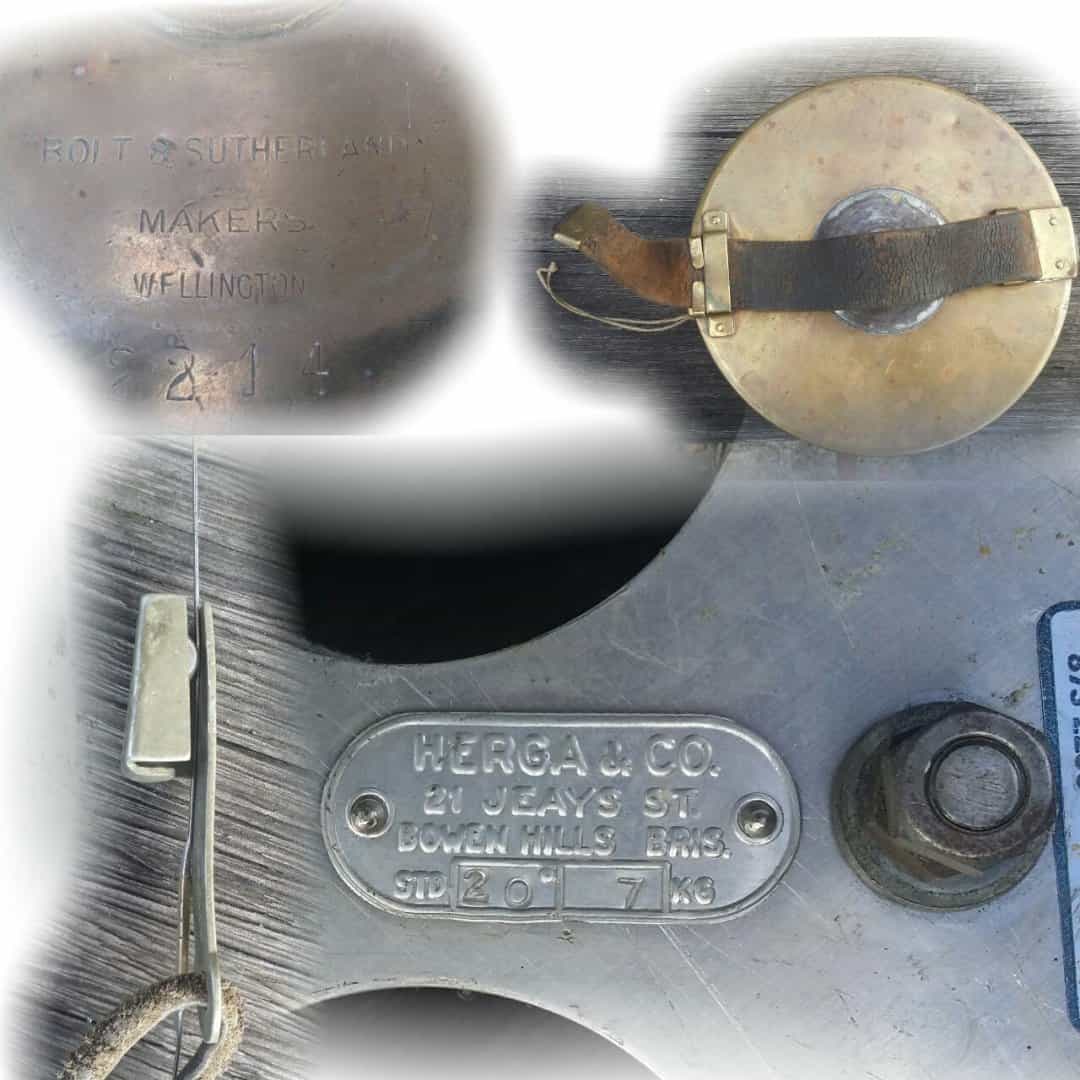I've just completed a road survey over an area I'd surveyed the boundaries of in 1977.
That was in the days of 100 metre steel bands, 1/16" wide, thermometer, spring balance and no forced centering. Just traversing to bush pickets as we called them.
(A small straight spar about 1å?ÛÏ öÉ, sharpened both ends and driven in the ground by quick successive series of thrusts with one or both arms)
I found 3 old marks. Spike in bitumen, brass disc in concrete ( a local height bench mark) and a å?" reo bar driven below ground.
What was pleasing was the agreement I had with original.
They were 350 metres apart each, and between each I measured 4 mm different.
Those old methods of survey, done properly with sag and temperature correction could be amazingly accurate.
My method was I'd pull up once, hold and measure, then relax and repeat three times in all.
That job had special significance for me.
It was one of the first of several surveys my wife and our twins would turn up with a picnic lunch.
We'd light a fire, boil the billy and have billy tea, at times barbecued steak or chops.
They were good times with fond memories.
Back in the day when the Highway Dept. was trying to go 'metric' we all got metric equipment such as level rods, roll-up tapes and steel tapes.
The steel tapes were 20m and 100m. While we did use the 20m chain for referencing corners and the like; I don't think we ever unrolled the 100m chain, it just looked way too big. My hat is off to someone that can consistently pull good numbers on a 100m tape.
Richard, post: 350515, member: 833 wrote: Those old methods of survey, done properly with sag and temperature correction could be amazingly accurate.
My method was I'd pull up once, hold and measure, then relax and repeat three times in all.
Yes, but for some reason few of the local surveyors bothered with temperature corrections or used a tension handle. Scale errors of 1:2000 in old taping aren't unusual. I'm working on one right now where a City of Austin survey party actually made the corrections for temperature and reported a line as 1336.67 ft. in length that I'd say was more likely 1336.70 ft. long. It's sadly the exception to the rule.
I never did any geodetic control with a tape, but I did do a fair amount of urban, suburban and rural boundary control on one end or another of a tape. We never used tension handles, and we only approximated the temperature corrections. When I've had occasion to follow up on some of those boundaries with modern equipment, a line like the one Kent described would likely come in somewhere between 1336.55 and 1336.85.
We had strict standards here and they were mostly (I assume by results seen) adhered to.
We were required by regulation to adhere to them.
Those measurements (Jim quoted) above would not be accepted here and find disciplinary action forthcoming.
We had winter and summer chains.
From memory standardised to about 12å¡ C and. 22å¡ C.
That minimised the temperature issues.
They'd be custom made for us.
They would be re-standardised each year.
Even our Spring Balances were checked.
Wind was the biggest issue when using 100 metre chains.
Due to their light weight they would be in full catenary inverted sag.
Not being sure what to deduct, I just assumed from observation the 'sag' deduction to be same as in full sag catenary.
I've an old 600' band on a brass drum reel.
They were heavy devices and after much use would decide to act like a coiled spring, which is where mines at.
Now they were interesting things to measure with.
FWIW, we used Lufkin Pioneer 1/4" tapes, mostly 100- and 200-foot variants, but sometimes 300-footers. Slope-chaining 300 feet required a well-braced stance in order to hold the 300-foot mark steady against the instrument index mark. It was a struggle for me to be rear chainman, as the pull required to minimize sag was often enough to pull my 135-lb. self off balance.
Jim they would be heavy chains.
Our thickest (widest) were ÉÝÛÏ and mainly used for engineering works where accuracy wasn't supreme.
They were also shorter.
We would make our own 20 metre ones from old, worn out chains.
One old trick we'd play was when chaining in rural areas with electric fences.
I'd hold the chain by its leather thong attached to tie it off on the reel.
As I'd walk along the chain would somehow come in contact with the fence. Oops, and fireworks from the other end.
Richard, post: 350648, member: 833 wrote: As I'd walk along the chain would somehow come in contact with the fence. Oops, and fireworks from the other end.
That was a standard hazing practice aimed at green rear chainmen. I experienced it once when I was one of the latter, but learned my lesson and never took my eyes off the head chainman whenever he got near a fence.
Here's a collection of old paraphernalia from days past.
Circular slide rule, scale rule (worse for wear), chain grip, chain scale, chain menders, picket card (red, white), 100 metre and 600 foot band (chain), scribes for bridge work, Brass SPM (State Permanent Mark), BM (levelling bench mark), thermometer

Survey pickets. These are not very long, usually full 6' 
Chain menders
Kent McMillan, post: 350637, member: 3 wrote: Yes, but for some reason few of the local surveyors bothered with temperature corrections or used a tension handle. Scale errors of 1:2000 in old taping aren't unusual. I'm working on one right now where a City of Austin survey party actually made the corrections for temperature and reported a line as 1336.67 ft. in length that I'd say was more likely 1336.70 ft. long. It's sadly the exception to the rule.
What am I missing?
Or am I just not understanding...
1336.70 - 1336.67 = 0.03
0.03 : 1336
1 : x
x = 44,533
what is your states' minimum error of closure?
JEFLS From Jims response. "a line like the one Kent described would likely come in somewhere between 1336.55 and 1336.85"
0.3 feet in 1336 feet.
That's was my inference.
We used a 300' chain all the time back in the day....
Chaining clamps, temp correction, the tension pullers, used them all....
Still use the chains, there are survey jobs they are more useful for than GPS or total stations.
JEFLS, post: 350655, member: 1771 wrote: What am I missing?
Or am I just not understanding...
1336.70 - 1336.67 = 0.03
0.03 : 1336
1 : x
x = 44,533what is your states' minimum error of closure?
If I read correctly, this is one of those times where Kent is actually showering praise on a survey party of yesteryear.
I believe Kent is saddened that the results that he lists above are rare to find.
JEFLS, post: 350655, member: 1771 wrote: What am I missing?
Or am I just not understanding...
1336.70 - 1336.67 = 0.03
0.03 : 1336
1 : x
x = 44,533
The point was that was a case where temperature corrections were applied and the results show it. It is not typical of the results one sees when taped work is remeasured.
There was a time when the surveying job paid by the mile.
The book "Three Dollars Per Mile" chronicles and sets in perspective the early versions of the requirement.
In the early 1970s some contracts required a mile a day at a fixed rate and they wanted quantity before quality. Most of this was easement work that also turned into rural electric construction control.
Much of that rubbed off on how some of the land surveying was being accomplished and it was common for the taped work to fall in the 1 in 1000 ft or less accuracy.
Thank goodness those hurried techniques did not fair well and not all brush apes were allowed to measure.
Kent McMillan, post: 350667, member: 3 wrote: The point was that was a case where temperature corrections were applied and the results show it. It is not typical of the results one sees when taped work is remeasured.
The other feature of urban surveying is how common it was for measurements made along the centerlines of streets to be made with the tape flat on the pavement. Of course, it was difficult to measure tape temperature under those conditions. When the ambient air temperature was 95å¡F, the asphalt pavement might be 140å¡F or more and that tended to wreck the calculation if the ambient temperature was used.
I'm looking at another line that was taped along a street on August 27, 1931 where a modern remeasurement shows these discrepancies:
704.50 (1931) vs. 704.77 (Actual)
348.00 (1931) vs. 348.10 (Actual)
The systematic nature of the shortage of the 1931 measurements strongly suggests a failure to correct the taping for a temperature difference between 45å¡F and 60å¡F above that for which the tape was standardized.
"Back in THE DAY," when I was working for a firm in SLC, we had two chaining procedures (using "tension handles" in both cases).
1. Short distance, medium accuracy temperature corrections were based on ambient temperature (Taylor Thermometer reading suspended from tripod in the shade).
2. Long distance, or Precise Traverse, Higher accuracy temperature corrections based on "Chain Thermometer" (average of 2, 1 on each end of the Tape).
These thermometers were specifically designed for the purpose of reading the actual temperature of the tape itself. As I recall (it's been over 40 years ago), these units were made by K&E, and were nearly a foot long. They were attached directly to the tape, in such a way that that the Mercury "bulb" was in direct contact with the steel tape.
As Kent pointed out above, the difference between ambient (air) temperature, and the actual temperature of the Tape, was ALWAYS (at least) a little different, and OFTEN, MUCH different (particularly so in the summer).
The company had its own "baseline" (periodically re-measured with an INVAR tape), which each crew was required to check their Tapes (chains) against on a regular basis (as well as ANY TIME they suspected a change in the tape length).
Ahhhh...the good ol' days (not).
Loyal
Jim Frame, post: 350646, member: 10 wrote: FWIW, we used Lufkin Pioneer 1/4" tapes, mostly 100- and 200-foot variants, but sometimes 300-footers. Slope-chaining 300 feet required a well-braced stance in order to hold the 300-foot mark steady against the instrument index mark. It was a struggle for me to be rear chainman, as the pull required to minimize sag was often enough to pull my 135-lb. self off balance.
We usually had four man crews so would put two guys on each end.
"Extra Guy" linked his arm through the Main Guy's arm.
If high end could be at/near ground level then one guy no problem there.
Think we pulled about 35lbs
Richard, post: 350515, member: 833 wrote:
We'd light a fire, boil the billy and have billy tea
Ok, for those of us on the other side of the world, what does that mean?
[USER=1965]@C Billingsley[/USER]
Ok, for those of us on the other side of the world, what does that mean?
Not sure what you'd call it but this is it.
The 'can' with the handle is a 'Billy'. Fill with water and when boiling throw in desired amount of tea.
When 'done' the leaves sink to bottom and time to enjoy.
It's an old device goes back yonks (ages) - probably an Aussie item when first settled as it is the subject of poems and ballads.
Here's a video that depicts the very essence of 'the billy', bit long but it's better watching than some of those 'lets bake a cake using the new thermogimeeyourmoney gadget'.
"My Old Black Billy" Ballad






